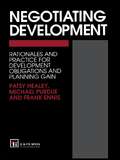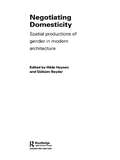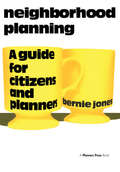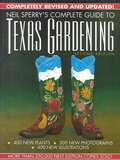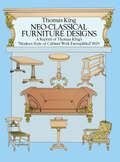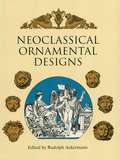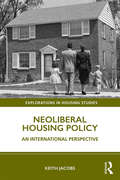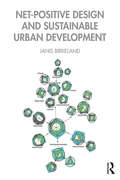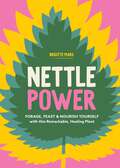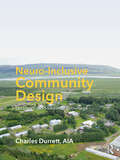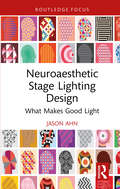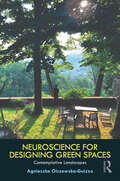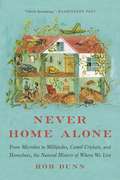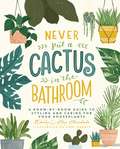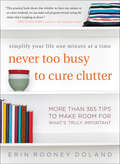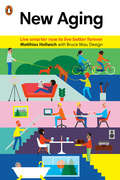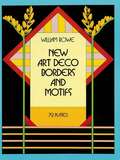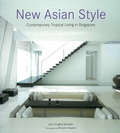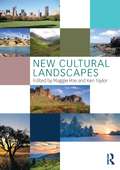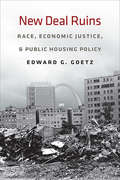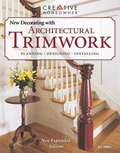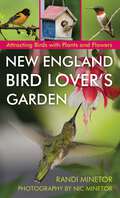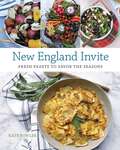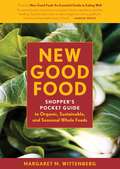- Table View
- List View
Negotiating Development: Rationales and practice for development obligationsand planning gain
by Frank Ennis F. Ennis P. Healey Prof Patsy Healey M. PurduePlanning gain is the legal process by which property development is linked to social provisions. This book examines the rationale for planning gain and development obligations and reviews the practice of development negotiation through a wide range of case histories.
Negotiating Domesticity: Spatial Productions of Gender in Modern Architecture
by Hilde Heynen Gülsüm BaydarIn the home the intricate relations between architecture, gender and domesticity become visible. Negotiating Domesticity investigates the many and complex themes evoked by the interconnections between these terms. Topics covered include famous as well as less well-known architectural examples and architects, which are explored from sociological, anthropological, philosophical and psychoanalytical approaches. The authors explore the relationships between modern domestic spaces and sexed subjectivities in a broad range of geographical locations of Western modernity. This richly interdisiplinary work presents architects and postgraduate students with an in-depth exploration of domesticity in the modern era.
Neighborhood Planning: A Guide for Citizens and Planners
by Bernie JonesFirst published in 1990. Routledge is an imprint of Taylor & Francis, an informa company. This guide explains neighborhood planning for both citizens and professionals. It explains what information to collect, where to get it, and how to assess it; how to pinpoint key issues, set clear goals, and devise strategies to achieve them; and how to package, implement, and update the final plan. Although this book could be used by citizens working alone, Jones advocates a team approach—citizens and professionals planning together. He highlights which tasks are best suited to the professional and how the planner should manage his role as intermediary between the city administration and residents. Jones also takes a detailed look at the neighborhood plan itself. Numerous maps illustrate how to inventory environmental features, land uses, circulation systems, and design features.
Neil Sperry's Complete Guide to Texas Gardening
by Neil Sperry#4 on Publishers Weekly's Bestselling Gardening Books list! This new, completely revised edition has over 500 new photographs, 400 new illustrations, 400 new plants and trees, the latest pest control recommendations, fruit and vegetable recommendations, new tips and plants specifically for Southern Texas, plus everything in the first edition.
Neo-Classical Furniture Designs: A Reprint Of Thomas King's Modern Style Of Cabinet Work Exemplified, 1829
by Thomas KingInfluential guide displays over 300 Grecian designs: fire screens, sofas, couches, chairs, footstools, commodes, sideboards, washstands, bedsteads,and many other items.
Neoclassical Ornamental Designs
by Rudolph AckermannGraphic artists, illustrators, desktop publishers - anyone in search of elegant classical ornament - will find a wealth of usable material in this handy resource, reproduced from rare 19th-century portfolios. Readers can choose from borders, corners, vignettes, cartouches, busts, ornamental designs, and many other configurations depicting gods and goddesses, mythical animals, floral and foliate motifs, urns, chariots, helmets, angels and cherubs, columns, figures from classical mythology, and more - all in fine-line renderings that convey a sense of timeless elegance and classical ambience. Ideal for adding pictorial interest to book and magazine illustrations, advertisements, brochures, and many other projects, these designs comprise an easy-to-use, copyright-free reference that belongs at the fingertips of anyone wishing to create eye-catching graphics with a classical touch.
Neoliberal Housing Policy: An International Perspective (Explorations in Housing Studies)
by Keith JacobsNeoliberal Housing Policy considers some of the most significant housing issues facing the West today, including the increasing commodification of housing; the political economy surrounding homeownership; the role of public housing; the problem of homelessness; the ways that housing accentuates social and economic inequality; and how suburban housing has transformed city life. The empirical focus of the book draws mainly from the US, UK and Australia, with examples to illustrate some of the most important features and trajectories of late capitalism, including the commodification of welfare provision and financialisation, while the examples from other nations serve to highlight the influence of housing policy on more regional- and place-specific processes. The book shows that developments in housing provision are being shaped by global financial markets and the circuits of capital that transcend the borders of nation states. Whilst considerable differences within nation states exist, many government interventions to improve housing often fall short. Adopting a structuralist approach, the book provides a critical account of the way housing policy accentuates social and economic inequalities and identifies some of the significant convergences in policy across nations states, ultimately offering an explanation as to why so many ‘inequalities’ endure. It will be useful for anyone in professional housing management/social housing programmes as well as planning, sociology (social policy), human geography, urban studies and housing studies programmes.
Net-Positive Design and Sustainable Urban Development
by Janis Birkeland‘Sustainable’ urban planning, policy and design professes to solve sustainability problems, but often depletes and degrades ever more resources and ecosystems and concentrates wealth and concretize social disparities. Positive Development theory holds that development could create more net ecological and social gains than no construction at all. It explains how existing conceptual, physical and institutional structures are inherently biased against the preservation and expansion of social and natural life-support systems, and proposes explicit reforms to planning, design and decision making that would enable development to increase future options and social and natural life-support systems – in absolute terms. Net-Positive Design and Sustainable Urban Development is aimed at students, academics, professionals and sustainability advocates who wonder why existing approaches have been ineffective. It explains how to reform the anti-ecological biases in our current frameworks of environmental governance, planning, decision making and design – and suggests how to make these changes. Cities can increase both the ‘public estate’ (reduce social stratification, inequity and other causes of conflict, increase environmental quality, wellbeing and access to basic needs, etc.); and the ‘ecological base’ (sequester more carbon and produce more energy than used during construction and operation, increase ecological space to support ecological carrying capacity, ecosystem functions and services, restore the bioregions and wilderness, etc.). No small task, this new book provides academic theory and professional tools for saving the planet, including a free computer app for net-positive design.
Nettle Power: Forage, Feast & Nourish Yourself with This Remarkable Healing Plant
by Brigitte MarsA colorful, highly accessible guide to the healing and culinary uses of nettle, a protein-packed wild plant that is a favorite of foragers and herbalists.Nettle Power is a fascinating exploration of the many uses of nettle for food, medicine, and fiber. A plentiful wild plant with a long history of use by both European and Native American herbalists, nettle helps soothe skin conditions, strengthen bones, increase milk production in lactating mothers, restore the nervous system, purify the blood, and boost the immune system, among its many benefits. The plant's sting is easily neutralized by blanching and author Brigitte Mars shares a range of recipes for using the nutrient-dense green leaves as a tasty substitute for spinach or chard in salads, soups, and main dishes, along with healing recipes for teas, tinctures, juices, and elixirs. Colorful illustrations and curious facts and lore make this a highly browsable and useful handbook for foraging, herb, and natural health enthusiasts.
Neuro-Inclusive Community Design: Lessons from Sólheimar Ecovillage
by Charles DurrettThis book is an inspiring exploration of Sólheimar Ecovillage in Iceland, a pioneering community that embodies sustainability, social responsibility, and inclusivity.Cohousing expert Charles Durrett delves into the unique aspects of this ecovillage of about 100 residents, 45 of whom include those with developmental and intellectual disabilities, who live and thrive alongside neighbors in a safe and enriching environment. Through rich storytelling and detailed first-person accounts, the book highlights the importance of creating communities that celebrate and support neurodiversity. Durrett presents Sólheimar as a model for how we can build neuro-inclusive spaces that respect and uplift every individual’s potential, fostering a sense of belonging and purpose. The book offers practical insights into the design, the principles, and the practices that make Sólheimar a standout community for inclusive living. It challenges readers to rethink conventional approaches, advocating for environments where all people, regardless of their cognitive differences, can live meaningful and fulfilling lives. Durrett also presents case studies of four other neuro-inclusive communities, including Hertha Levefallesskab, WeBUILT (We Build Unique Independent Lives Together), Creative Living Community of CT, and L’Arche International Movement. With its focus on real-world solutions and its call to action, this book is both a guide and an inspiration for anyone interested in the intersection of sustainability, community living, and neuro-inclusivity.It will have a broad audience of architects, designers, occupational therapists, mental health professionals, housing developers, and practitioners in housing and social care, among others.
Neuroaesthetic Stage Lighting Design: What Makes Good Light
by Jason AhnNeuroaesthetic Stage Lighting Design redefines stage lighting through the lens of neuroaesthetics, exploring how light shapes human perception, emotion, and experience. Interweaving science, philosophy, and art, it reveals the power of lighting to enhance beauty and meaning on the stage.This book provides a comprehensive exploration of the aesthetic and functional principles of light by weaving together multiple threads of interdisciplinary integration, faithful reproduction of natural light, scientific foundation, and visual symbolism. It explores lighting that mimics originals, including natural light to enhance beauty and audience immersion, explains the biological and psychological effects of light on human experience, and examines how set, lighting, costumes, and videos contribute to the performance's imagery and audience perception. By using scientifically informed lighting design, the book seeks to create immersive and fully emotional performances. It encourages lighting designers to adopt an interdisciplinary, artistically informed approach and provides valuable insights into the lighting design process, surpassing traditional technical manuals.A compelling read for theatre professionals, designers, students and researchers of neuroaesthetics, and anyone curious about the meaning and reasons behind beauty, Neuroaesthetic Stage Lighting Design reimagines lighting as an essential component of human experience and artistic excellence.
Neuroscience for Designing Green Spaces: Contemplative Landscapes
by Agnieszka Olszewska-GuizzoUrban parks and gardens are where people go to reconnect with nature and destress. But do they all provide the same benefits or are some better than others? What specific attributes set some green spaces apart? Can we objectively measure their impact on mental health and well-being? If so, how do we use this evidence to guide the design of mentally healthy cities? The Contemplative Landscape Model unveils the path to answer these questions. Rooted in landscape architecture and neuroscience, this innovative concept is described for the first time in an extended format, offering a deep dive into contemplative design and the science behind it. In the face of the global mental health crisis, and increasing disconnection from nature, design strategies for creating healthier urban environments are what our cities so sorely need. This book delves into the neuroscience behind contemplative landscapes, their key spatial characteristics, and practical applications of the Contemplative Landscape Model through case studies from around the world. Landscape architects, urban planners, students, land managers, and anyone interested in unlocking the healing power of landscapes will find inspiration here.
Never Home Alone: From Microbes to Millipedes, Camel Crickets, and Honeybees, the Natural History of Where We Live
by Rob DunnA natural history of the wilderness in our homes, from the microbes in our showers to the crickets in our basements <P><P>Even when the floors are sparkling clean and the house seems silent, our domestic domain is wild beyond imagination. In Never Home Alone, biologist Rob Dunn introduces us to the nearly 200,000 species living with us in our own homes, from the Egyptian meal moths in our cupboards and camel crickets in our basements to the lactobacillus lounging on our kitchen counters. You are not alone. <P><P>Yet, as we obsess over sterilizing our homes and separating our spaces from nature, we are unwittingly cultivating an entirely new playground for evolution. These changes are reshaping the organisms that live with us--prompting some to become more dangerous, while undermining those species that benefit our bodies or help us keep more threatening organisms at bay. <P><P>No one who reads this engrossing, revelatory book will look at their homes in the same way again.
Never Put a Cactus in the Bathroom: A Room-by-Room Guide to Styling and Caring for Your Houseplants
by Emily L. HinsdaleFuel your houseplant obsession with this beautifully illustrated room-by-room guide to bringing the outdoors inside—perfect for plant parents everywhere!Millions of plant lovers and newbie gardeners are discovering the joys of bringing plants into their homes. Not only do they add a fresh, natural touch to any room, they also have serious mood-boosting power, and help to reduce stress, improve air quality, and even provide fresh herbs for that next meal! It&’s a no-brainer that houseplants can improve our quality of life—but how do you maximize their benefits without sacrificing style. Full of home design and practical plant care tips as well as more than 70 plant recommendations, Never Put a Cactus in the Bathroom is an illustrated guide to help you choose the right plants for your space, from succulents and spider plants to pothos and ZZ plants. A Houseplant 101 section will set you off on the right foot, covering essentials of plant care and maintenance, as well as basic troubleshooting, and a primer on the health benefits of indoor plants. Then, going room by room, you will find space-specific recommendations, such as: -Purifying the air in your bedroom with low light beauties -Decorating your bathroom with air plants and ferns—your shower powers the climate is they need to thrive! -Creating a living centerpiece for your dining room or breakfast nook -Adding a low-maintenance bamboo or jade plant to your home office for motivation and focus -Growing a windowsill herb box or hydroponic tomato to level up your next meal Perfect for fans of Wild at Home, Urban Jungle, and Wellness by Design, this book will give plant lovers the tools and confidence they need to bring houseplants into every corner of their homes, improve their quality of life, and turn their home into a natural sanctuary.
Never Too Busy to Cure Clutter: Simplify Your Life One Minute at a Time
by Erin Rooney DolandMore than 365 tips to give you the advice and motivation you need to kick-start your home organizing project on your schedule.Whether you have thirty seconds, one minute, five minutes, or fifteen minutes, this organizing daily devotional offers tips, checklists, weekend projects, quizzes, and encouragement that will help you find the time, motivation, and permission to let go of sentimental clutter, set up storage solutions, and establish routines that make sense for your life.Filled with practical advice and small, doable projects that were created with your busy life in mind, Never Too Busy to Cure Clutter is a loyal resource, as well as a workbook, that you can rely on for straightforward, inspiring advice and tips you can return to time and time again.Yes, you’re busy, but you’re never too busy to cure clutter.
New Again: 100+ projects and ideas to reimagine your furniture and decor
by Geneva VanderzeilA masterclass in upcycling, restoration and creative transformation by one of the world's leading DIY experts. Geneva Vanderzeil – author of Home Is Where You Make It and founder of Collective Gen – has been a trend-maker in the DIY space for 15 years, inspiring millions with her unique approach to seeing the potential in everything. In New Again, she shares over 100 innovative projects and ideas along with tips and expert techniques to transform furniture and decor. For beginner and expert DIYers alike, this extensive guide covers everything from painting and timber restoration to tiling and upholstery. Whether you're rescuing a roadside find, revamping a second-hand piece or breathing new life into something you already own, you will find the skills and inspiration in this book to create with confidence. With step-by-step tutorials, impressive before and afters and Geneva's signature creative approach, New Again is the ultimate DIY handbook that will change the way you see furniture, decor and your own potential.
New Aging: Live Smarter Now to Live Better Forever
by Matthias Hollwich Bruce Mau DesignAging is a gift that we receive with life--and in New Aging, the architect Matthias Hollwich outlines smart, simple ideas to help us experience it that way. New Aging invites us to take everything we associate with aging--the loss of freedom and vitality, the cold and sterile nursing homes, the boredom--and throw it out the window. As an architect, Matthias Hollwich is devoted to finding ways in which we can shape our living spaces and communities to make aging a graceful and fulfilling aspect of our lives. Now he has distilled his research into a collection of simple, visionary principles--brought to life with bright, colorful illustrations--that will inspire you to think creatively about how you can change your habits and environments to suit your evolving needs as you age. With advice ranging from practical design tips for making your home safer and more comfortable to thought-provoking ideas on how we work, relax, and interact with our neighbors, and even how we eat, New Aging will inspire you and your loved ones to live smarter today so you can live better tomorrow.From the Trade Paperback edition.
New Art Deco Borders and Motifs (Dover Pictorial Archive)
by William RoweThis collection of 72 full-page black-and-white Art Deco designs offers artists and craftspeople royalty-free, ready-to-use borders, frames, and motifs. Abstract geometric forms contrast with foliate and floral elements in dynamic designs. Useful in graphic arts, textile and upholstery design and more.
New Asian Style
by Masano Kawana Jane Doughty MarsdenMore than ever before, interior design is a global affair. And more than ever, Westerners are eager to try out elements of Asian design. This book is the ultimate resource for professional and amateur designers seeking to recreate the mysterious elegance, balance, and beauty of Asian design. Through the magic of Masano Kawana's beautiful full-color photography, New Asian Style explores more than 30 stunning contemporary houses and homes from Singapore, all of which stand as examples of decorating and style that transcend their Eastern origins. In an effort to help designers pick up Asian ideas for their own settings, Jane Marsden's essays examine what elements make Asian style and how they might be captured in new settings anywhere in the world.
New Cultural Landscapes: Challenges And New Directions
by Maggie Roe Ken TaylorWhile historical and protected landscapes have been well studied for years, the cultural significance of ordinary landscapes is now increasingly recognised. This groundbreaking book discusses how contemporary cultural landscapes can be, and are, created and recognised. The book challenges common concepts of cultural landscapes as protected or ‘special’ landscapes that include significant buildings or features. Using case studies from around the world it questions the usual measures of judgement related to cultural landscapes and instead focuses on landscapes that are created, planned or simply evolve as a result of changing human cultures, management policy and practice. Each contribution analyses the geographical and human background of the landscape, and policies and management strategies that impact upon it, and defines the meanings of 'cultural landscape' in its particular context. Taken together they establish a new paradigm in the study of landscapes in all forms.
New Deal Ruins: Race, Economic Justice, and Public Housing Policy
by Edward G. GoetzPublic housing was an integral part of the New Deal, as the federal government funded public works to generate economic activity and offer material support to families made destitute by the Great Depression, and it remained a major element of urban policy in subsequent decades. As chronicled in New Deal Ruins, however, housing policy since the 1990s has turned to the demolition of public housing in favor of subsidized units in mixed-income communities and the use of tenant-based vouchers rather than direct housing subsidies. While these policies, articulated in the HOPE VI program begun in 1992, aimed to improve the social and economic conditions of urban residents, the results have been quite different. As Edward G. Goetz shows, hundreds of thousands of people have been displaced and there has been a loss of more than 250,000 permanently affordable residential units. Goetz offers a critical analysis of the nationwide effort to dismantle public housing by focusing on the impact of policy changes in three cities: Atlanta, Chicago, and New Orleans. Goetz shows how this transformation is related to pressures of gentrification and the enduring influence of race in American cities. African Americans have been disproportionately affected by this policy shift; it is the cities in which public housing is most closely identified with minorities that have been the most aggressive in removing units. Goetz convincingly refutes myths about the supposed failure of public housing. He offers an evidence-based argument for renewed investment in public housing to accompany housing choice initiatives as a model for innovative and equitable housing policy.
New Decorating with Architectural Trimwork
by Jay SilberNew Decorating with Architectural Trimwork focuses on the aesthetic, uses architectural trim work. Plenty of books tell the reader how to install trimround windows and doors, but few also explain how architectural trim can enhance a room's aesthetic appeal. Silber shows readers even more idea so now to choose and use a wide variety of moldings, trim, and design concept to transform the all-too-common sterile, open floor plan into a warm, inviting, richly textured home, providing ideas for how to decorate homes with trim and wall panels so that walls, passageways, and stairways can radiate the warmth, character, and beauty of the well-trimmed homes.
New England Bird Lover's Garden: Attracting Birds with Plants and Flowers
by Randi MinetorNew England Bird Lover's Garden helps you maximize your home birding experiences and attract a wider variety of birds. With over 100 full-color photos and concise, informative text, it provides indispensable details on what foods, plants, trees, water sources, and nesting materials will attract particular species. It helps you make the right choices the first time—and avoid costly mistakes.
New England Invite: Fresh Feasts to Savor the Seasons
by Kate BowlerClassically, deliciously New England.This essential cookbook for the New England table gives the seasoned host and the busy novice the ingredients they need to fill their plates and homes. New England Invite is the complete package for creating a welcoming, beautiful, fun feast for all seasons. More than 70 seasonal recipes make for great gatherings all year round. Sidebars include local wine and beer pairing tips, guides to seasonal blooms, and super doable DIY projects to make any party pop, from a family clam bake to harvest-season pumpkin porch parties. Author Kate Bowler captures the spirit of New England cooking and presentation to get friends and family excited to celebrate and make life entertaining.
New Good Food Pocket Guide, rev: Shopper's Pocket Guide to Organic, Sustainable, and Seasonal Whole Foods
by Margaret M. WittenbergThis convenient pocket guide packs the knowledgeable information of the original whole foods bible into a concise, easy-to-carry format. Focusing mainly on core food products available at large-scale supermarkets and natural foods stores, easy-reference entries help shoppers navigate their many options when choosing organic, whole, local, and sustainably and ethically produced foods. An updated pocket-size edition of the definitive guide to buying, storing, and preparing whole foods. Handy charts and tables summarize what's in season when. Organic food sales totaled nearly $17 billion in 2006, up 22 percent from the previous year, in the U.S. alone. From the Trade Paperback edition.
